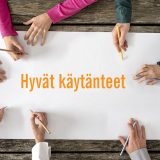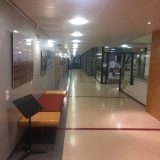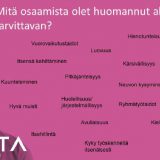Testing Finnish educational methods abroad
After almost one year of fascinating studies at OAMK School of Vocational Teacher Education here came the time to apply what we have been learning in the teaching practice. While being on maternity leave with six month baby at that time the only good option was to go to my home country – Lithuania.
You might think that going back to where you come from to test your teaching skills is not as fancy as going to some exotic country far away, but I would argue that for me it was a nice challenge. After living, studying, and working in Finland for five years a lot of ‘Finnishness’ turned to be in my blood. Moreover, the last year spent in OAMK made a huge breakthrough and completely changed my understanding about creativity while teaching; learning by doing; student-centered classroom, and many other things that we explored over the studies. But will it work in a country, which I knew to be rather traditional in teaching methods, meaning where courses are conducted predominantly by lecturing; students have separate sessions for lectures and practice, and where group work guided by pre-tasks is not a day-to-day activity.
I ended up teaching in the biggest polytechnic in Lithuania – Vilnius University of Applied Sciences – for an English group studying International Business. First year students should have learned from me everything about the Corporate Social Responsibility during the five week period.
First good news were that my class is going to be rather small – 15 students only. Interactive classroom should work just fine while having five groups with three people! After email with an introduction about myself and invitation to the course only 6 students showed up in the first lecture … That was brilliant start, especially knowing that groups, according to my plan, should have been formed during that very first lecture. And here adjustments began! It took more than one week to get everyone attending the lectures and doing the pre-tasks. Students were not particularly happy with pre-tasks, especially the longer ones, and I had to quit one of them and explain topic by myself together with paper assigned instead of conducting the usual group activity.
Nevertheless, I must say that students were very smart and very-much into business (many of the students in Lithuania work already from the first year of their studies – this is one of the major reason for low attendance). So discussions and activities went very well as soon as the new study method was accepted.
The other fear which I had was how a male-dominated group will be reacting to doing poster presentations on the analysis of the company/situation cases (i.e. lot’s of drawing in almost in every class!). I was pleasantly surprised that students started asking with excitement “What we will draw today?”. Meaning that instead of getting lost among new diagrams and shapes assigned for that day, they became very involved with different tools for analysis and presentation. After these interactive sessions it was rather easy to keep student attention on the short lecture which was meant to wrap up the topic highlighting the major points in the theme. Nevertheless, as soon as I included some longer lecture in the middle (by getting back to what I assumed is more comfortable way for them to learn, since this is what they are used to) – immediately the ocean of smart phones showed up in their hands and eyes sank down to them…
Thus, after ‘tasting’ the ‘Finnish way of learning’ students were not very keen on getting back to the ‘old stuff’. On the top of that, I believe that the Finnish way of teaching allowed me to build a good relationship with students rather quickly. Although they knew that I am going to be really strict and none of them will get away without doing the tasks assigned, in the end they were approaching me with very open discussions and even shared a lot of personal issues.
All in all, it was a wonderful try for me while applying what I have learned in OAMK/Amok, Finland. Obviously, ‘Finnish methods’ were enjoyed by the students as well, since course received evaluation of 4,8 out of 5. For now, I only hope that Finland will offer more education on pedagogy in English which I could attend and that I will have more chances to apply my knowledge received in Finland and abroad.
Aušrinė Šilenskytė










